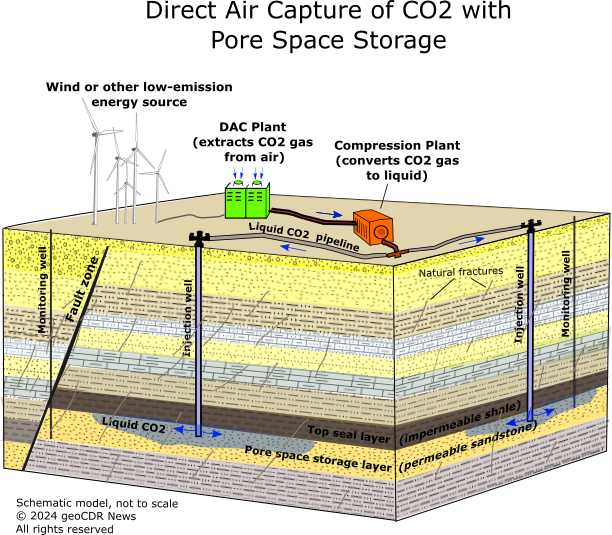New study:
Earth's capacity for storing CO2 underground in pore space may be much less than expected
Storing captured CO2 as a semi-liquid in the tiny pore spaces of sedimentary rock underground is widely considered to be one strategy for reducing global warming. CO2 would be captured from industrial emissions (carbon capture and storage, CCS) and industrial direct air capture plants (direct air capture with pore space storage, DACPS).

Rock layers in sedimentary basins throughout the world have been widely estimated to have enough pore space to ultimately store a total of gigatonnes. This far exceeds the 2,000 GtCO2 that has been widely viewed as requiring storage by the year 2100 — suggesting there should be no concern about adequate future storage capacity.
But a new modelling study (see below) estimates the worldwide storage capacity may be only 1,460 GtCO2 when environmental, land use and other non-geologic factors are taken into account, along with drilling depth limitations. Capacity of only 1,460 GtCO2 indicates there could be a shortage of capacity, considering the need for up to 2,000 GtCO2 of storage.
The authors of the article describing the study point out that a shortage of storage capacity may create an intergenerational conflict, with one generation needing to ration their storage to preserve adequate storage for the following generation. Progress in emissions reduction will dictate the amount of capture and storage needed by each generation.
The study did not evaluate the potential CO2 storage underground in igneous rocks such as basalt whereby CO2 is trapped via carbon mineralization (e.g., direct air capture with carbon mineralization storage, or DACCM). The study cited the limited field testing of carbon mineralization as a storage method as the reason for not evaluating it.
A copy of the article is provided below.
"A prudent planetary limit for geologic carbon storage"
From: Nature, Vol 645, No. 4, September 2025 (full attribution at bottom of page)
- Title: A prudent planetary limit for geologic carbon storage
- Author(s): Matthew J. Gidden, Siddharth Joshi, John J. Armitage, Alina-Berenice Christ, Miranda Boettcher, Elina Brutschin, Alexandre C. Köberle, Keywan Riahi, Hans Joachim Schellnhuber, Carl-Friedrich Schleussner, and Joeri Rogelj
- Source: Nature, Vol 645, No. 4, September 2025
- Rights and License: Copyright © 2025 The authors. Creative Commons Attribution License (CC BY)